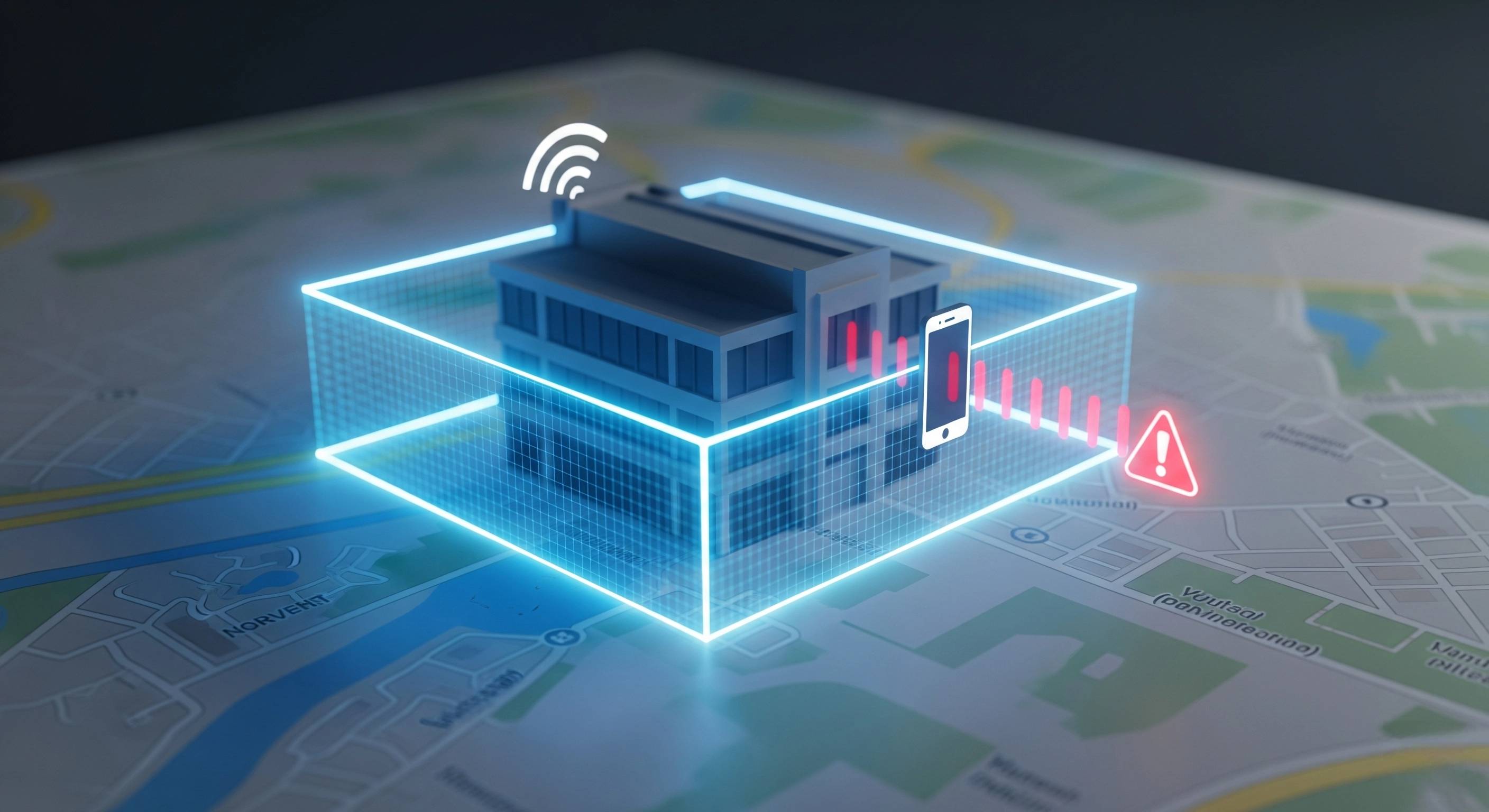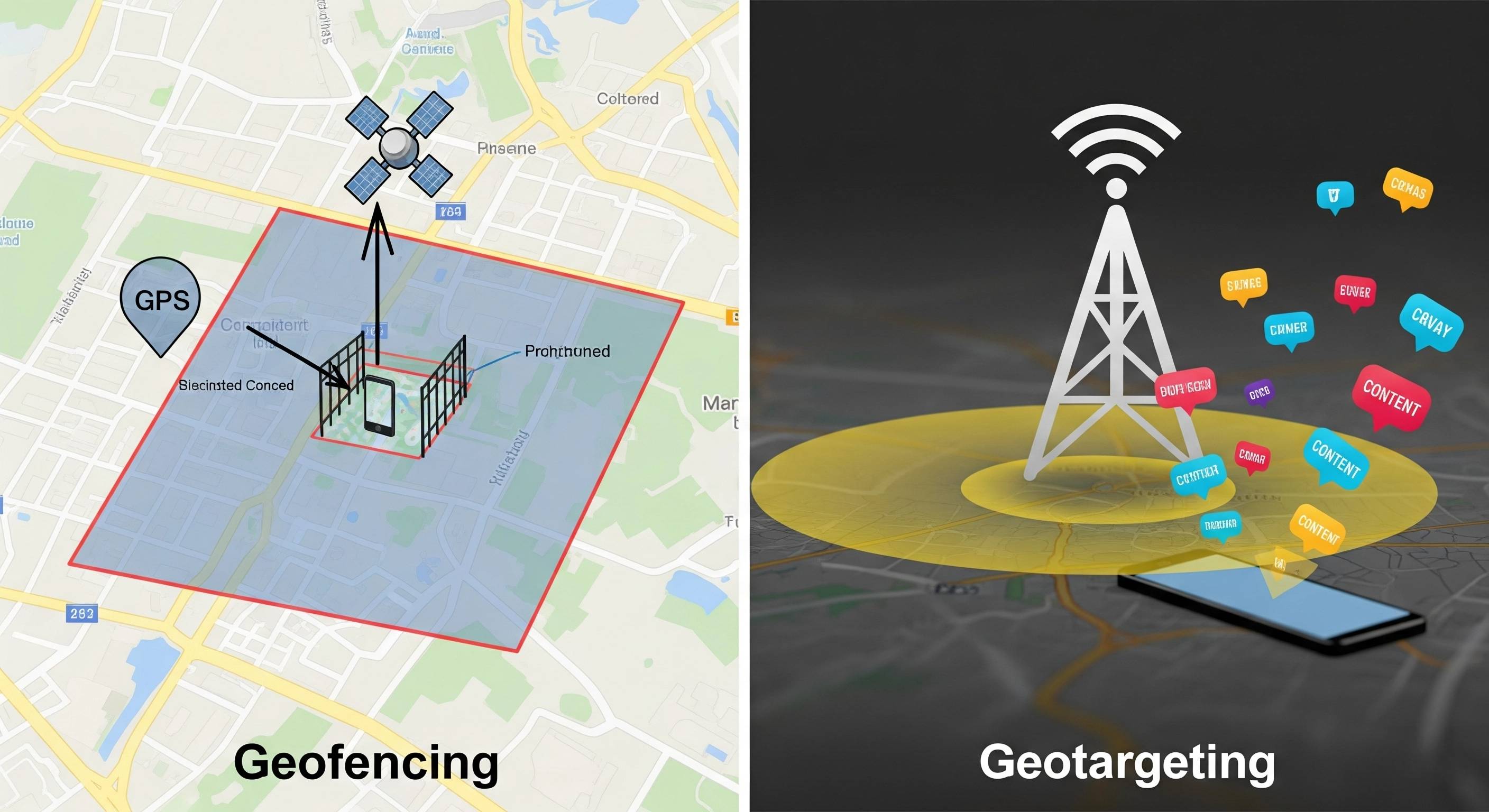- Provides device grouping and member management for accountability.
- Enables monitoring and alerts for device status, battery, location, and CPU/memory.
- Offers remote control, desktop access, and camera/microphone access for troubleshooting.
- Boost operational productivity, streamline daily tasks
Geofencing vs Geotargeting: What's the Key Difference for Businesses?
- 1 : Geofencing vs Geotargeting: Core Definitions
- 2 : The Key Differences Between Geofencing and Geotargeting
- 3 : Applications: When to Use Geofencing vs Geotargeting
- 4 : Why Geofencing Matters for MDM Solutions Like AirDroid Business
- 5 : Tips: Navigating Privacy in Location-Based Technologies
- 6 : Conclusion: Choosing the Right Tool for Your Business Goals
1Geofencing vs Geotargeting: Core Definitions
Let' start with a thorough understanding of both concepts.
What is Geofencing?
Geofencing is a location-based technology that uses GPS, Wi-Fi, Bluetooth, or cellular networks to create a virtual 'fence' around a specific physical area (such as an office park, warehouse, retail store, etc.). When a mobile device enters, leaves, or stays within the boundary, a preset action is automatically triggered.
For example, a mobile device management (MDM) solution like AirDroid Business can lock a company-owned tablet when it leaves a designated work area or send an alert to an IT administrator when a device enters a restricted area. The advantage is that it can provide real-time, action-oriented responses to location changes."

What is Geotargeting?
Geotargeting is a marketing-oriented technique that pushes customized content to users based on their geographic location, such as city, postcode, or region. It uses IP address or historical location data to segment the audience and push relevant information - such as a cafe promoting a discount to users within a 5-mile radius, or a retailer promoting a local promotion.
Unlike geofencing, geotargeting is "passive":
It does not rely on virtual boundaries or trigger instant actions, but is about achieving precise reach of information."

2The Key Differences Between Geofencing and Geotargeting
To clearly understand the difference between geofencing and geo-targeting, we compare them from multiple dimensions. Below are the areas where they differ the most, thus making them suitable for different applications.

Technology Deployed
Geofencing relies heavily on real-time positioning technologies, such as GPS and Bluetooth beacons, to monitor the movement of devices within virtual boundaries. In contrast, geo-targeting primarily uses IP addresses and historical location data to determine the approximate area of the user.
User Interaction
Geofencing is an active technology that interacts with the user's device behavior and can respond immediately to the device entering, leaving, or staying within the boundary. Geo-targeting, on the other hand, is a passive approach that does not interact with the user's device in real-time. Instead, it uses location data to push content while the user is using the device.
Precision Level
Geofencing is highly accurate, typically 1-100 meters, and is suitable for small, specific areas;
Geotargeting is medium accuracy, and is generally targeted at larger areas such as cities, regions, or postal codes.
Resource Requirements:
Implementing geo-fencing may require more technical resources, including integration with a device management system and, in some cases, building specific hardware; geo-targeting is relatively simple to implement and can usually be achieved with the help of advertising platforms and analytics tools.
Scalability:
Geofencing is more suitable for small and medium-sized areas and may be challenging to scale to very large areas; geotargeting can easily scale to cover large geographic areas, such as an entire country or continent.
3Applications: When to Use Geofencing vs Geotargeting
Based on the differences above, each one of the two approaches has different applications. Let u explore which one of them is suitable for which purpose for businesses.
Geofencing: Ideal for MDM and Security
Geofencing is a core feature of mobile device management (MDM) solutions such as AirDroid Business, and is particularly useful in scenarios that require strict control and compliance:

Asset Tracking and Recovery:
Enterprises can set up geo-fences for valuable devices such as laptops and tablets. Once a device leaves a designated area (such as an office area or warehouse) without authorization, the system will immediately trigger an alarm to help quickly track and recover it.
For example, a construction company uses AirDroid Business to set up a fence around the construction site. If a company tablet used for project management is taken away from the site, the IT team will be notified immediately and remotely lock the device to prevent data leakage."
Employee Productivity Management:
For field teams, geofencing ensures that employees work within their designated areas. Managers receive alerts if a field employee's device is outside of their designated work area, helping to ensure productivity.
For example, courier companies can use geofencing to demarcate delivery areas. If a delivery driver's device is outside of their designated area, managers receive notifications so they can intervene and adjust the route."
Data Protection in Sensitive Industries:
In fields such as medicine and finance that require extremely high data security, geo-fencing can limit access to sensitive data in unauthorized areas.
For example, a hospital uses AirDroid Business to set up a fence around the hospital. When a doctor's tablet storing a patient's medical records is taken away from the hospital, the system will automatically block access to the medical record system to prevent private data from being leaked.
Geotargeting: Built for Marketing and Engagement
Geo-targeting is designed to improve marketing accuracy and user engagement, pushing personalized content by combining location and user characteristics:

Localized Promotions:
Offline retail, catering, and other formats can push discounts to surrounding users through geo-targeting to attract in-store consumption.
For example, a cafe pushes a ‘10-yuan discount on in-store purchase’ coupon to users within 3 kilometers, or a gym promotes a "new user experience course" to residents in the surrounding community, directly increasing the store visit rate in the area.
Event Marketing:
Exhibitions, concerts, and other events can promote tickets to users in surrounding cities through geo-targeting, or accurately reach potential participants by combining user interest tags (such as "music lovers").
For example, music festival organizers can push early bird ticket discounts to users within 50 kilometers who have followed similar events, greatly improving ticket sales efficiency."
Service Customization:
Local service platforms such as food delivery and housekeeping can recommend nearby resources based on user locations through geographic targeting. For example, food delivery platforms push "lunch packages" to users in office-dense areas and highlight "dinner discounts" to users in residential areas, making service information more in line with scene needs.
4Why Geofencing Matters for MDM Solutions Like AirDroid Business

Geofencing is not an add-on feature of MDM tools, but a core capability of solutions like AirDroid Business. Its value lies in three key dimensions:
Comprehensive Device Visibility:
AirDroid Business can track the location of all managed devices in real time. IT administrators can intuitively monitor the movement of devices through the dashboard to ensure that the devices are always used in authorized areas.
This visualization capability helps optimize the efficiency of device allocation, such as quickly locating idle devices and redeploying them to the departments in need to avoid wasting resources.
Intelligent Automation:
The platform supports the creation of complex automation rules based on geo-fencing. For example, when a device enters the fenced area of a conference room, the system can automatically mute notifications to avoid disrupting the meeting; after leaving, the notification function is automatically restored.
This automation mechanism greatly reduces manual operation costs, freeing the IT team from repetitive tasks and focusing on more core technical support work.
Enhanced Compliance Management:
Industries such as healthcare and finance are subject to strict regulations and have clear specifications for data processing and device usage.
AirDroid Business's geo-fencing feature helps companies meet regulatory requirements by ensuring that devices are used within compliant areas and automatically protecting sensitive data when devices leave authorized areas. The platform automatically generates detailed reports on device locations and activities, providing a complete chain of evidence for audit work and reducing compliance risks."
AirDroid Business - Device Management
AirDroid Business is a device management solution that can be used to enroll, manage, and monitor large fleet devices. With the centralized platform, organizations are able to deploy smartphones, tablets, rugged devices and others dedicated devices like kiosks and digital signage.
It's available for Cloud Deployment & On-Premises Deployment.
Key features include: remote access & control, Google Play apps & enterprise's apps management, policy, single & multi-apps kiosk mode, alerts & automated workflows, geofencing & location tracking, file transfer, notification, user management, reports, etc.
5Tips: Navigating Privacy in Location-Based Technologies
While both location-based services are a great means of enhancing data security, productivity, and targeted marketing for businesses, companies need to strictly adhere to privacy protection regulations when using the. Below is an account on how AirDroid Business acknowledges this fact and ensures compliance with privacy laws.
Privacy Best Practices for Geofencing (Especially in MDM)
- Only necessary data is collected. For example, AirDroid Business can limit the tracking of whether the device has crossed the border, without recording real-time coordinates.
- Use end-to-end encryption to protect the transmission and storage of location information to prevent data leakage.
- For BYOD devices, users must be clearly informed of the purpose of geofencing and obtain explicit authorization to avoid default activation.
Privacy Considerations for Geotargeting
- Avoid storing precise personal locations and prefer using anonymized regional data (e.g., "users in a certain city").
- Provide clear opt-out options so that users can turn off location-based push notifications at any time.
- Clearly state in the privacy policy the use of location data, e.g., "for pushing local offers."
6Conclusion: Choosing the Right Tool for Your Business Goals
Although both geo-fencing and geo-targeting are location-based technologies, they serve very different business needs. When choosing between them, you need to focus on your core goals:
If your core needs are device control, security protection or compliance management (such as preventing company equipment leakage, monitoring field team tracks, and protecting sensitive data), geofencing is an irreplaceable tool. Especially MDM solutions such as AirDroid Business, whose geofencing function can build a complete closed loop from "location monitoring" to "risk response" for enterprises through real-time location tracking, automated rule triggering (such as device out-of-bounds locking), detailed compliance reports, etc., which is impossible to achieve with geo-targeting.
If your focus is marketing acquisition, user interaction or regional content push (such as promoting store discounts to surrounding users, pushing event information to people in a specific city), geo-targeting can play a greater role. It combines IP addresses with user tags to accurately reach people "in a specific area and with interest characteristics", which is suitable for industries such as retail, catering, culture and tourism that need to expand brand voice.
It is worth noting that the two are not in opposition. Enterprises can use them in combination. In the final analysis, the core of technology selection is "matching scenarios":
Geo-fencing is the "digital border guard" of enterprises, and geo-targeting is the "precision reach tool" of marketing. By clarifying whether you need "control actions" or "content push", you can turn every bit of technology investment into a driving force for business growth.
FAQs








Leave a Reply.